Urban Exploring Techniques: Elevator Surfing
When I was an undergraduate, a group of us decided that we wanted to get
on the roof of the tallest building on campus to view the fireworks
display in a neighboring town. Many of the older buildings on campus
simply had a ladder mounted to the wall on the top floor or attic which
led to a roof hatch. The building we had selected was a more modern
construction.
After climbing the stairwells and finding the roof access secure, we
tried to find another way up. After much experimentation, we found that
we could ride on the building's elevators to the top of the shaft, where
a grate in the ceiling led to the mechanical room for the elevator
systems. Once in this room, we could simply walk out to the roof.
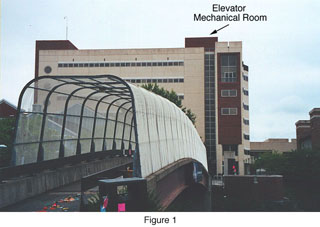
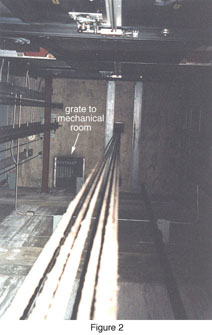
 After that discovery, we rode on top of several elevators on campus, both
for fun and to access otherwise inaccessible places. In this article, I
describe the method we used to ride the elevators. Note that this method
only works for elevators with doors that open in the center.
After that discovery, we rode on top of several elevators on campus, both
for fun and to access otherwise inaccessible places. In this article, I
describe the method we used to ride the elevators. Note that this method
only works for elevators with doors that open in the center.
Getting on Top of the Elevator
The first thing we tried was the obvious method of climbing through the
ceiling hatch of the elevator car. We could not get it open and later
found out that it was bolted shut from the top. We determined that we
would instead have to stop the elevator between floors, and climb out
through the front.
When a person boards an elevator, they pass through two sets of doors.
The outer doors are attached to the building frame and are designed to
open only when the elevator is stopped at their floor. The inner doors
are part of the elevator car. To get on top of the elevator, one must be
able to open the inner doors between floors, trip the latch for the outer
doors, and climb out and then on top of the elevator.
The first thing to do is to stop the elevator between floors. We
initially tried pressing the elevator stop button, but found out that
this set off an alarm. However, we found that we could manually open the
inner doors by pulling them apart with our hands; when the doors were
opened about an inch, the elevator came to a stop quickly (as a safety
feature).
Once the elevator is halted, open the doors fully and see where you are
in the shaft. The goal is to position the elevator in such a way that
you have access to the opening mechanism on the outer doors (typically
located near the top of the doors), while still having enough space to
crawl out of the elevator.
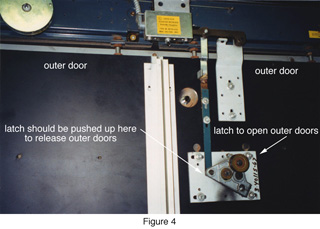
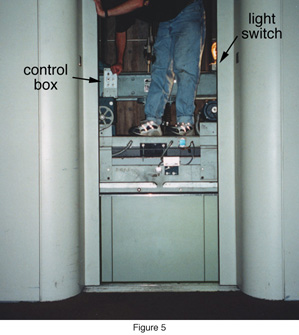 Once the elevator is at the desired position, manipulate the latch on the
opening mechanism to open the outer doors [Figure 4]. This can be done
by hand, but is more easily (and safely) done using a rod of some sort.
Once the latch is activated, you should be able to easily pull the outer doors
open by hand, and climb out of the elevator onto the floor outside.
[Figure 5] (On most of the split-door elevators I've seen, the outer
doors will open a few centimeters while locked, giving you a chance to
see what's going on outside. This is a good thing, since opening the
outer doors to find yourself staring at someone's legs can come as a rude
surprise.)
Once the elevator is at the desired position, manipulate the latch on the
opening mechanism to open the outer doors [Figure 4]. This can be done
by hand, but is more easily (and safely) done using a rod of some sort.
Once the latch is activated, you should be able to easily pull the outer doors
open by hand, and climb out of the elevator onto the floor outside.
[Figure 5] (On most of the split-door elevators I've seen, the outer
doors will open a few centimeters while locked, giving you a chance to
see what's going on outside. This is a good thing, since opening the
outer doors to find yourself staring at someone's legs can come as a rude
surprise.)
Once outside, take a look on top of the elevator. There should be a
light switch somewhere on top to activate a work light. There also
should be a control box containing several buttons and/or switches for
operating the elevator from above. Take a close look at the control box.
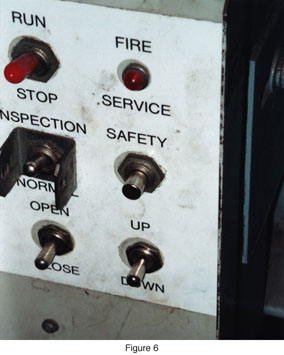 There should be a switch to put the elevator into a maintenance mode
[Figure 6] (labeled "Inspection" in the above figure). By activating this switch, the elevator
should only move under manual control. There should also be a "Run/Stop"
switch. Put this switch in the Stop position and the maintenance mode switch
in the Inspection position. Find a safe spot to stand on the elevator, and climb on!
There should be a switch to put the elevator into a maintenance mode
[Figure 6] (labeled "Inspection" in the above figure). By activating this switch, the elevator
should only move under manual control. There should also be a "Run/Stop"
switch. Put this switch in the Stop position and the maintenance mode switch
in the Inspection position. Find a safe spot to stand on the elevator, and climb on!
Operating the Elevator
The control panel on top of the elevator should have a switch which moves
the elevator up and down. This is often used in conjunction with a
"dead-man's switch" (labeled "Safety" in the above image), which will
only let the elevator move while it is
being actively pressed. By using these controls, you can
control the elevator as desired. The elevator should move much more
slowly in in Inspection mode than it does in normal operaton (make sure
to put the "Run/Stop" switch back in the Run position).
Getting Off the Elevator
To get off the elevator, simply bring the top of the elevator level with
a floor, open the outside doors, and step off. Using the control panel,
put the elevator back into "Normal" mode, and let the outside doors
close. Make sure that the inner doors are closed or else the elevator
will be stuck where you left it.
Fun Things To Do
By controlling the elevator from the top, you should be able to get
access to restricted floors which can't be accessed normally without an
elevator key. You may also be able to access the mechanical room for the
elevator, which may lead somewhere interesting (such as the roof of the
building, or a sub-basement).
Another thing I'm fond of doing is to put the elevator back in "Normal"
mode while remaining on the elevator. You can spend as long as you like
on top while people use the elevator. Some interesting conversations can
often be heard!
Safety and Caveats
When doing this type of thing, the usual common-sense safety rules apply.
It's a good idea to have someone you know outside (or inside!) the
elevator who can help if something goes wrong. The elevator should not
move when the inside doors are open, but safety mechanisms can fail - be
careful entering and exiting when the elevator is between floors. It's
probably a good idea to manually take the elevator all the way to the top
of the shaft before riding in Normal mode to see what kind of clearance
you have. Be careful near the edges of the elevator where objects are
moving; don't, as one of my friends did, peer over the back of the
elevator and nearly get hit by the counterweight.
When opening the inside doors to stop the elevator, try it first before
the elevator comes up to full speed (and don't stick your fingers out too
far!).
Although this technique has worked for us many times, we have admittedly
only tried this on a relatively small number of elevators. Every
elevator is different - be careful, and have fun!
Disclaimer
Elevator surfing has inherent dangers. Do it at your own risk. The above
information is for informational purposes only, and is in no way guaranteed
to be safe or accurate.








